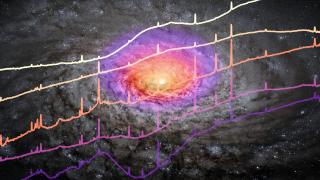Bibcode
García-Lorenzo, Begoña; Monreal-Ibero, Ana; Mediavilla, Evencio; Pereira-Santaella, Miguel; Thatte, Niranjan
Bibliographical reference
Frontiers in Astronomy and Space Sciences
Advertised on:
12
2019
Citations
4
Refereed citations
4
Description
We present preliminary results on the potential of HARMONI, the first light integral field spectrograph for the ELT, to explore the evolution of central super massive black holes (SMBH) - host galaxy relation in the range from z̃0.7 to z̃2.5. We simulated HARMONI observations of QSO+host galaxy at different redshifts, assuming different morphologies for the host galaxy. As input, we combined MUSE observations of nearby galaxies and a theoretical QSO spectrum. These were dimmed and redshifted to the desired cosmic epoch. We scaled the total host galaxy luminosity to three different values, sampling three orders of magnitude. Likewise, we assumed two different luminosities for the central QSO. Simulations were performed for the 30×60 mas2 HARMONI spatial scale and LTAO working at 0.67 arcsec seeing. The selected wavelength range (i.e. 4700-5300 A ̊ at rest-frame) was sampled at the lowest HARMONI spectral resolving power (i.e. R̃3200). This configuration included all the ingredients to estimate the host galaxy parameters and the SMBH mass, as well as for assessing the morphological type of the host galaxy.
Related projects

Nuclear Activity in Galaxies: a 3D Perspective from the Nucleus to the Outskirts
This project consists of two main research lines. First, the study of quasar-driven outflows in luminous and nearby obscured active galactic nuclei (AGN) and the impact that they have on their massive host galaxies (AGN feedback). To do so, we have been granted time with the Gran Telescopio CANARIAS (GTC) in the optical and near-infrared ranges
Cristina
Ramos Almeida